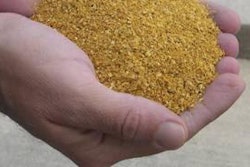Rapeseed meal is becoming for Europe what DDGS has become for the United States: an unavoidable byproduct of the biofuel industry that must be recycled through animal feed. And, like DDGS, rapeseed meal is not without its own unique challenges that with proper control can reduce its attractiveness as a replacement of soybean meal.
Regrettably, rapeseed varieties most suitable for bio-fuel production contain the highest levels of anti-nutritional factors, making them the least desirable from an animal nutrition point of view. Nevertheless, if rapeseed meal from such varieties is to be used at high levels, as it is becoming the norm throughout the EU, the actual levels of glucosinolates and erucid acid in animal feed must be must controlled to avoid depressed performance and of course, ensure optimal animal health.
Pig feeds rich in rapeseed meal
In pigs, rapeseed meal is best suited for feeds destined for growing-finishing pigs (over 30 kg body weight), and secondly for gestating sows. In such pig diets, rapeseed meal is best limited to 10 percent or less of the final formula. If rapeseed meal from ‘double-zero’ varieties (that is from varieties with very low levels of glucosinolates and erucid acid) is available it is recommended to limit its inclusion to no more than 50 percent of normal soybean levels.
Poultry feeds with rapeseed meal
Diets for young birds and layers should include no more 2-3 percent normal rapeseed meal, increasing to up to 5 percent for older broilers. Again, levels can be increased to replace up to 25 percent of soybean meal levels if rapeseed with low levels of anti-nutritional factors can be sourced.
Glucosinolates as an index
It is always best to have actual laboratory values for anti-nutritional values, especially when large batches of rapeseed meal are purchased from the same source. With such data, it is possible to use rapeseed meal with more precision, at possibly higher inclusion levels, and without fear of affecting animal performance. Most laboratories can analyze for total glucosinolates (gluconapin, progoitrin, and glucobrassicanapin), and this is the most widely used index. Actual levels of total glucosinolates depend on variety and range from as low as 25 and up to 200 micro-mol/gram of meal.
In pigs, total glucosinolate content should be below 2 micro-mol/gram of feed for growing animals, and below 1 micro-mol for breeding animals. It is best not to use rapeseed in diets for young pigs.
In poultry, broiler growth starts to be affected at 2-4 micro-mol/gram of feed, is depressed about 10 percent at levels between 6–10 micro-mols and severely reduced at levels above 10 micro-mols. It is best to keep levels below 2 micro-mols for laying hens.

















